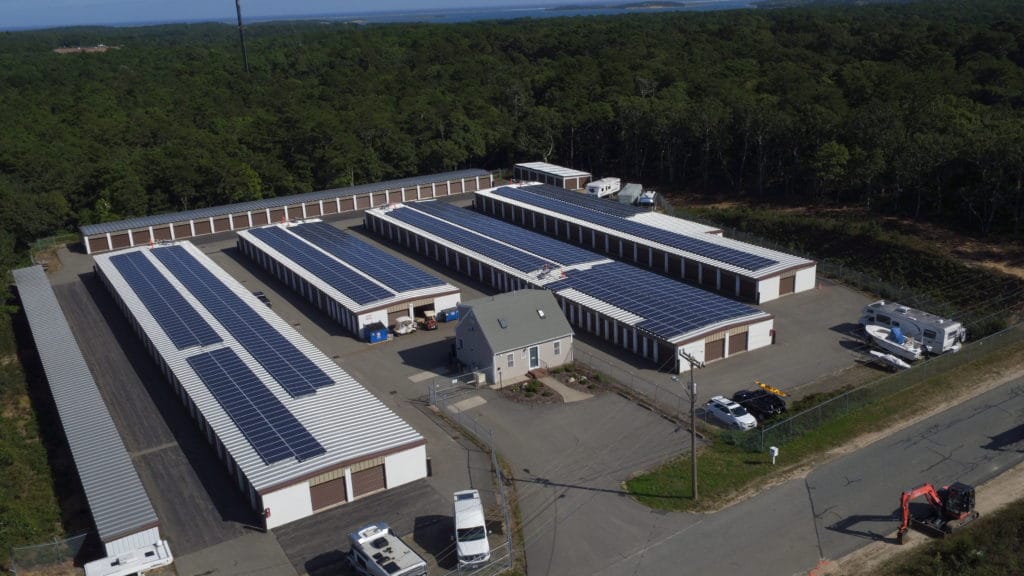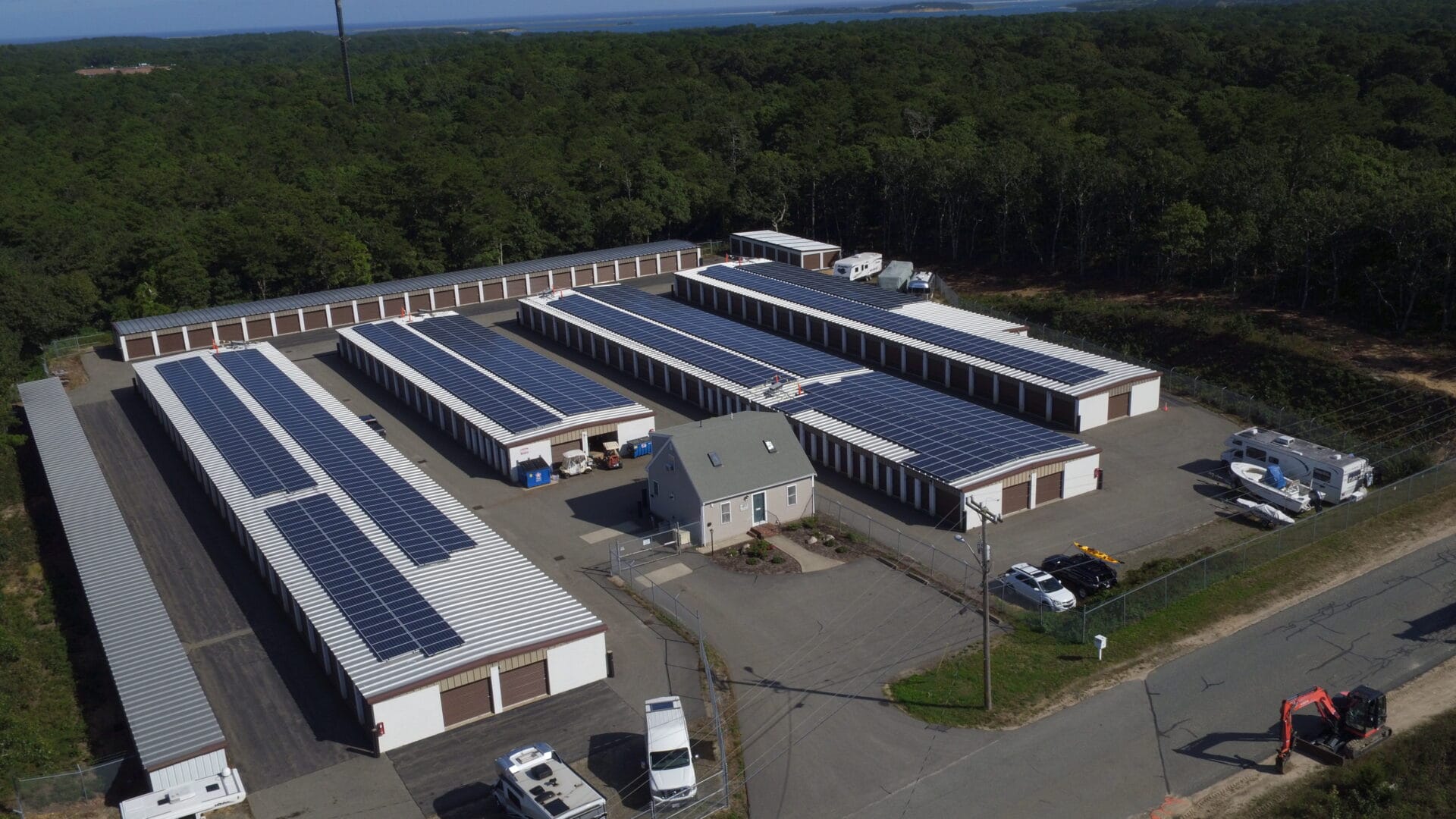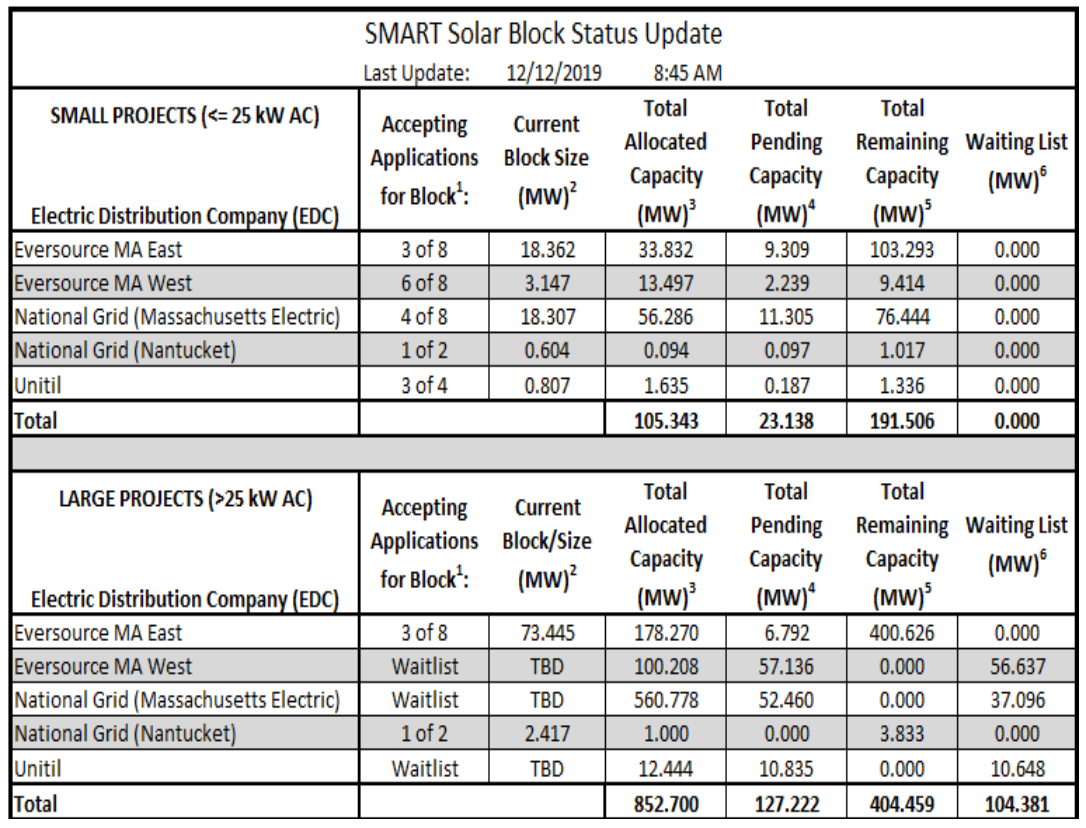
Our client, whose property is shown here, just got his first check through the SMART program.
This post is the third in our series about a 692 kilowatt rooftop solar power system in Brewster, Massachusetts. Here we will take a look at the SMART Program in Massachusetts: what the program is, how it works, and how you can apply and earn money for your solar system. Our client at Smart Security just received his first check from the state, so we can attest that the program is well worth the investment if you meet the requirements.
What is the SMART program?
The Solar MAssachusetts Renewable Target (SMART) Program describes how business owners that install solar power will be paid for the electricity they generate. Twenty year contracts are signed between Massachusetts and the system owners, and – depending on location, size, and when the customer applies – owners are paid monthly with electricity discounts or a deposit direct into a checking account. The program has a laid out plan of installing 1.6 gigawatts of solar panels – able to generate more electricity than 225,000 households would use.
The official page for the SMART program on Massachusetts government servers is located here.
We applied for our Brewster customer on day one that the program was live, and got into Block 1!
How does the SMART program work?
First, don’t be intimidated by the chart below! There are only a couple of pieces of information needed to navigate it. The first thing we look for is which of the below electric distribution company regions your project is within. This is important because different regions of the state are paid different amounts. Notice the various electric utilities to the left of the chart, and also notice that no municipal electricity companies included.
Next, look at the second column above: “Generation Unit Capacity”. This is the size range for your solar power project’s inverter. Smaller project inverters get paid more money, larger projects get less – but they all get paid decently.
Last major thing to look at is the “Block” number, the eight numbered columns to the right. The more solar that is installed, the more to the right we go down the Block list, and – pay attention here – the less we are paid. So, please do recognize that time matters.
If you like spreadsheets, you should check out the tools the state gives you here to figure this stuff out. At Secure Storage, because we had two unique legal entities involved, we installed two 250 kW AC solar power plants.
What is the net metering cap?
Net metering is an electricity accounting system that allows you to export unused solar power – usually between 10 AM and 2 PM – to the power grid to be used by your neighbors. Then, as the sun goes down, that electricity is credited to your account. One important detail on net metering in Massachusetts is that the electricity that is later credited, is only worth 60% of the amount it would have been worth if you used it when generated. This net metering fee is necessary to help support the power grid.
The above chart shows the available space in the net metering program on December 12. Notice that the column “Capacity Available” shows it is mostly gone, with only space in “NStar” – which is Eversource. This is because politicians have chosen to not use this technique as much, thus your system might not require net metering. We’ll figure that out once we review your electricity bills.
Since Secure Storage didn’t have much electricity usage, we decided to use the “Alternative Credit” program and not use net metering. This means 100% of the revenue goes into the customer’s bank account (see below tweet!).
The above chart, updated regularly, can be found on the official government page here.
Is my solar rebate taxable as income?
First off, we aren’t tax professionals – thus our advice should be double checked to make sure we’re right. But, if we are to use common sense, then we would tell you that any revenue the state pays you for your solar power incentive, would in fact be taxable. Our reasoning is, if you want to use all the tax benefits solar gives you in the first year – you cannot adjust the “depreciable base” based on tax payments coming two decades out. So, please, be careful and don’t overestimate the total amount of money you’ll have after Uncle Sam.
How much money does the SMART program pay?
The SMART program pays whatever the system design dictates by the rules. This number will be different for everyone. For instance, the state will pay a bonus if your system is on a roof, or another type of bonus if your system is a carport, or if you share your electricity with a group of people via “community solar”. As well, there are times money paid will drop; for instance if you build on prime farmland.
Really roughly speaking, for every 10,000 square feet of usable roof space your earnings will start around $25,000 a year.
One customer of Commercial Solar Guy got their first check below just a few weeks ago:
Here is the first check that a customer of mine got for their 692 kWdc solar power installation within the Massachusetts SMART system. Took two years from time we met, and this check represents about five months of back pay while the state got everything going correctly. #victory pic.twitter.com/Y2lF6aWkJe
— Commercial Solar Guy (@SolarInMASS) November 19, 2019
How do I apply for the Massachusetts SMART program?
There are a few steps. First, you have to apply for “Interconnection”. This is like getting permits to connect to the electricity grid. This application’s costs start at around $1,500 and can run towards $40,000 for the largest projects. Required as part of the application is a “Site Layout” and a “One Line Diagram” – these documents are done by an engineer, something that Commercial Solar Guy can help you with.
After interconnection is approved, which will take several months, you then apply for the SMART program here. You need to have a contract with an installer signed, proof of land and building ownership, a collection of legal documents and a copy of your interconnection report.
Commercial Solar Guy will help you get this document.
How long do I have to act?
Well, depending on where you are in the state the answer varies. First off, for people located in National Grid territory, I have bad news: the SMART program mostly filled up in the first couple of weeks. The official, up-to-date numbers can be found in the chart on this page (and in the below image as of December 12). Notice how the large projects (these are commercial business projects), are in Block 3 for Eversource East, and on a ‘Waitlist” for National Grid.
So you have a bit of time if you are in Eversource territory, but it is moving along fast. The National Grid region won’t get moving until later in 2020 or early 2021.
This article is the third in a series describing how we built a 692 kilowatt rooftop solar power system in Brewster, Massachusetts on top of Secure Storage. The first article – focusing on basic feasibility and cash flow – can be found here, and the second focusing on tax credits and the pre-application process here. Images of the project are located here.
***
If you are planning a solar development and you think it may qualify for the SMART Program, Commercial Solar Guy can guide you through the process. Get in touch today, and we’ll start with a free consultation.



